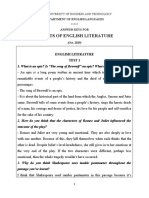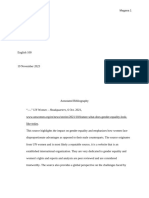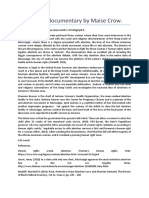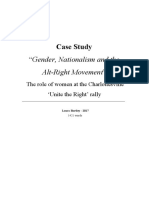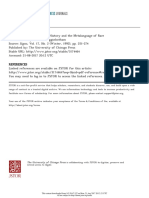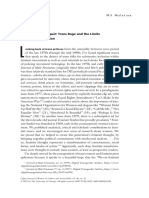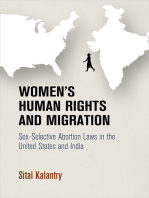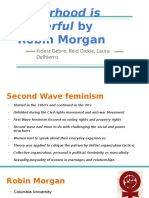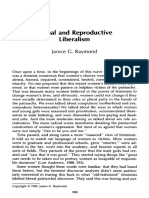This Content Downloaded From 93.156.218.154 On Thu, 20 Jul 2023 17:08:04 +00:00
This Content Downloaded From 93.156.218.154 On Thu, 20 Jul 2023 17:08:04 +00:00
Uploaded by
a.yucel1492Copyright:
Available Formats
This Content Downloaded From 93.156.218.154 On Thu, 20 Jul 2023 17:08:04 +00:00
This Content Downloaded From 93.156.218.154 On Thu, 20 Jul 2023 17:08:04 +00:00
Uploaded by
a.yucel1492Original Title
Copyright
Available Formats
Share this document
Did you find this document useful?
Is this content inappropriate?
Copyright:
Available Formats
This Content Downloaded From 93.156.218.154 On Thu, 20 Jul 2023 17:08:04 +00:00
This Content Downloaded From 93.156.218.154 On Thu, 20 Jul 2023 17:08:04 +00:00
Uploaded by
a.yucel1492Copyright:
Available Formats
The Relationship Between the "Invisibility" of African American Women in the American
Civil Rights Movement of the 1950s and 1960s and Their Portrayal in Modern Film
Author(s): Martha Lott
Source: Journal of Black Studies , MAY 2017, Vol. 48, No. 4 (MAY 2017), pp. 331-354
Published by: Sage Publications, Inc.
Stable URL: https://www.jstor.org/stable/26174202
JSTOR is a not-for-profit service that helps scholars, researchers, and students discover, use, and build upon a wide
range of content in a trusted digital archive. We use information technology and tools to increase productivity and
facilitate new forms of scholarship. For more information about JSTOR, please contact support@jstor.org.
Your use of the JSTOR archive indicates your acceptance of the Terms & Conditions of Use, available at
https://about.jstor.org/terms
Sage Publications, Inc. is collaborating with JSTOR to digitize, preserve and extend access to
Journal of Black Studies
This content downloaded from
93.156.218.154 on Thu, 20 Jul 2023 17:08:04 +00:00
All use subject to https://about.jstor.org/terms
Article
Journal of Black Studies
2017, Vol. 48(4) 331-354
The Relationship © The Author(s) 2017
Reprints and permissions:
Between the sagepub.com/journalsPermissions.nav
DOI: 10.1177/0021934717696758
"Invisibility" of African journals.sagepub.com/home/jbs
American Women in the
American Civil Rights
Movement of the 1950s
and 1960s and Their
Portrayal in Modern Film
Martha Lott
Abstract
This research argues that the representation of African American women in
modern civil rights film is a result of the "invisibility" that they faced during
the civil rights movement in America during the 1950s and 1960s. To make its
argument, this article contends that the media's scant but negative coverage
of women activists along with male leaders, such as Malcolm X's attitude
toward African American women during the period of the movement, is the
reason why ultimately African American women activists received lack of
recognition for their involvement in the movement. This work also argues
that the lack of recognition for these women is evident in modern civil rights
film and they negatively portray African American women's role during the
movement. This is shown by examining two films—Selma and The Help. This
work also debates whether using film as a historical source is correct. This
work touches upon the ongoing stereotypical role of "Mammy" in films such
as The Help and argues that overall, by studying various arguments, and as
historian Peniel Joseph believes, that many prestigious movies take dramatic
license with historical events, arguing that films are not scholarly books and
people should not learn about historical events through films.
Corresponding Author:
Martha Lott, UK.
Email: marthalott6@gmail.com
This content downloaded from
93.156.218.154 on Thu, 20 Jul 2023 17:08:04 +00:00
All use subject to https://about.jstor.org/terms
332 Journal of Black Studies 48(4)
Keywords
American Civil Rights Movement, American History, African American
Women's History
Introduction
This research will argue that the way African American women are repre
sented in modern film is a result of the "invisibility" that they faced during
the civil rights movement in America during the 1950s and 1960s. To make
its argument, this work will consider whether contemporary American film
reflects the ongoing anxieties and tensions of race, gender, and representation
that African American women faced during the civil rights movement. This
journal article will combine an examination of the civil rights movement with
(auto) biographical studies of the key women of the civil rights movement
alongside a focus on major civil rights films such as Selma (2015) Director
(Ava DuVernay) and The Help (2011) Director (Tate Taylor) in order to
examine their portrayal of African American women. Despite the key involve
ment of women in the movement, this research will show that modern film
still promotes a largely male vision of civil rights activists. This work will
also look at how "invisibility" becomes an issue for African American women
in American film in the sense that their contributions are not often recog
nized, and when they are, they rarely make it on to the "big-screen." After
surveying the scholarly literature around the topic, it is clear that there are
many arguments regarding African American women's involvement in the
civil rights movement. However, there is a lack of research undertaken by
scholars on African American women's representation in film on this subject.
This work will engage closely with the existing arguments on women's
involvement and, although sparse, the work on African American women's
representation in film. Charles Payne's (2007) work has led him to call the
civil rights movement "a woman's war" due to the African American wom
en's efforts during the movement (I've Got The Light of Freedom). According
to Payne (1990), "women canvassed more than men, showed up more often
at mass meetings and demonstrations and frequently attempted to register to
vote" (p.67)("Men Led but Women Organized"). Bernice Barnett (1993) also
contends that African American women suffered not only with the fight for
racial equality but from "The Triple Constraint" of racism, sexism and clas
sism (p. 162). However, LaVerne Gyant (1996) disagrees with Barnett in
"Passing the Torch: African American Women in the Civil Rights Movement"
(p. 629). Gyant (1996) argues that the "Triple Constraint" of race, gender, and
class faced by African American women during the civil rights movement
was not necessarily a bad thing. She contends that it empowered them to rise
This content downloaded from
93.156.218.154 on Thu, 20 Jul 2023 17:08:04 +00:00
All use subject to https://about.jstor.org/terms
Lott 333
above society's challenges and let them find freedom from racial oppression
(pp. 629-630). This research will disagree with Gyant's argument that the
"Triple Constraint" empowered women as they were fighting, sometimes
unknowingly, a larger battle and therefore this made the struggle harder. They
were fighting unknowingly, as Teresa A. Nance (1996) states in "Hearing the
Missing Voice," that regardless of the fact that male leaders in the civil rights
movement did not consider women as leaders, the women did not believe this
attitude to be sexist (p. 551). This article will work closely with the "Triple
Constraint" argument and apply it when relevant. Conversely, there is very
little research on African American women's representation in the civil rights
movement through the medium of film. The little research that does exist
refers to films of the 1980s and 1990s. This work will critically examine
contemporary films (21st century) in order to understand whether certain
gender biases in the portrayal of these women still exist. Historian Peniel
Joseph's "'Selma' Offers a Window Into the Civil Rights Movement" argues
that Selma (2015) director Ava DuVernay wisely chooses to ignore the stereo
types of presenting the film solely focusing on Martin Luther King Jr. and his
efforts during the movement. "'Selma' Offers a Window Into the Civil Rights
Movement" shows how DuVernay's film portrays the civil rights movement
in a historically accurate way, including mainly the African American women
organizers who were the backbone of the movement, but received limited
national media attention. Joseph states how the unlikely popular involvement
of African American women characters such as Annie Lee Cooper, Amelia
Boynton, and Diane Nash corrects many people's ideas that the civil rights
movement was led by solely men. This research will take this argument and
disagree as Jesse McCarthy (2015) argues that Selma director DuVernay
misses an opportunity to evoke a women's empowerment history. This work
will agree by stating that the representation of African American activists in
the civil rights movement in modern film is still overshadowed by the male
leaders and does not truly represent women's efforts in a historically accurate
way. On the contrary, the Association of Black Women Historians argue that
The Help (2011) is an "unacceptable" example of how Hollywood films can
"strip black women's lives of historical accuracy" in order to make an award
winning film. Their statement read, "Despite efforts to market the book and
the film as a progressive story of triumph over racial injustice, The Help dis
torts, ignores, and trivializes the experiences of black domestic workers"
(Association of Black Women Historians, 2011). This work will work closely
with this statement and add to this argument by suggesting that films such as
The Help focus solely on the White protagonists of the civil rights movement
when in reality it was organized and led by African American women and
men. However, Amy Curtis (2011) in her review of The Help disagrees with
This content downloaded from
93.156.218.154 on Thu, 20 Jul 2023 17:08:04 +00:00
All use subject to https://about.jstor.org/terms
334 Journal of Black Studies 48(4)
the Association of Black Women Historians. Curtis believes that it is purely
entertainment and the audience should concentrate on the performances
given by the actors as opposed to being critical of the historical content being
correct (Curtis, 2011). However, it is also important to make reference to the
older civil rights works. Although these are few, the comparisons of represen
tations are still essential. Mississippi Burning (1988) Director (Alan Parker),
for example, depicts women as secondary characters and the heroine must be
brought into the viewer's consciousness through the perspective of a White
male. Julian Armstrong (2015) contends that the film portrays the movement
through what he dubs the "Miss Daisy's Perspective," where a White pro
tagonist becomes the hero of the vulnerable, Black character (p. 86). Jonathan
Rosenbaum (1988) also argues that some of these critics are too far removed
from the historical facts to realize the extent of the film's distortions. When
studying history along with film, it is important to look at critical scholarship
on using film as a historical source. Film and history scholar Robert
Rosenstone (1995) believes that "film is a disturbing symbol of an increas
ingly post literate world" (p. 18). The potential problem of using film as a
historical source, as previously mentioned by the Association of Black
Women Historians, is that the film will almost never portray the historical
facts one hundred percent accurately. The argument is that Hollywood films
tend to "strip black women's lives of historical accuracy," and historical
events as a whole, in order to make an award winning film (Association of
Black Women Historians, 2011). However, it is also important to consider the
debate, as Amy Curtis does, that film is purely entertainment and the audi
ence should concentrate on the performances given by the actors as opposed
to being critical of the historical content being correct (Curtis, 2011). The
research will be presented in two chapters. The first chapter features experts
from civil rights movement activists like Gwendolyn Zoharah Simmons and
Doris Adelaide Derby. This section will also examine Fred Powledge's "Free
at Last?: The Civil Rights Movement and the People Who Made It," featuring
primary sources from Diane Nash, another civil rights activist from the time,
where she talks of how the civil rights movement affected women harder than
men—the "Triple Constraint" effect that Bernice Barnett often talks of. This
part of the research will also look at the reasons why African American
women activists were "invisible" during the civil rights movement. In order
to do this, it is essential to look at the views of the male leaders and also the
role of the media. The second chapter will focus on two films—The Help
(2011) and Selma (2015). This part of the research will examine why African
American women have not received the "big-screen" treatment that men
have received in terms of acknowledgment of their contribution to the civil
rights movement. This chapter will also look at how the roles of African
American women during the civil rights movement are portrayed in the films
This content downloaded from
93.156.218.154 on Thu, 20 Jul 2023 17:08:04 +00:00
All use subject to https://about.jstor.org/terms
Lott 335
and will examine whether their portrayal is historically accurate. Chapter 2
will also examine why African American women are not represented by well
known actresses unlike their male counterparts who are portrayed by famous
actors, for instance, Denzel Washington starring in the film Malcolm X(1992)
Director (Spike Lee). Chapter 2 will also look at how "invisibility" becomes
an issue for African American women in American film in the sense that their
contributions are not often recognized, and when they are, they rarely make
it on to the "big-screen." In summary, this work will show that the representa
tion of African American women in modern civil rights film is a result of the
"invisibility" that they faced during the civil rights movement in America in
the 1950s and 1960s. It will also show how modern film still portrays the
civil rights movement as a male-led movement, ignoring the efforts of African
American women.
Chapter I—The African American Women of the
Civil Rights Movement
When students learn about the civil rights movement, they are usually taught
about Martin Luther King Jr. and Malcolm X. Occasionally, Rosa Parks is
mentioned and rarely Coretta Scott King too, with a great emphasis placed on
the fact that they are women. No such remarks are made about the gender of
Martin Luther King Jr. or Malcolm X. However, the likes of African American
women activists such as Ella Baker, Diane Nash, Fannie Lou Hamer, Annie
Lee Cooper, and Angela Davis still are never mentioned when students learn
about the civil rights movement. The main thesis of this chapter is to examine
the reasons why African American women were overlooked during the civil
rights movement. In order to do this, it is essential that this section must start
by looking at African American women activists during the civil rights move
ment through a variety of sources that feature firsthand accounts from the
women themselves. It is essential to do this because these primary sources
will show the activists talking of their experience of Historian Bernice
Barnett's theory of the "Triple Constraint." Civil Rights Movement Veterans,
1963 noted in 1988, the enemy is never a person, it is always an attitude such
as racism or sexism, "some kind of system of attitude that oppresses"
Therefore, it is essential to secondly look at the oppressor itself, the attitude
of the men in the movement, in order to assess why these women did not
receive the recognition they deserved. This will feature a critical examination
of Malcolm X, as he was one of the most popular male leaders of the move
ment, who was always in the public limelight. In order to critically examine
why these important women were overlooked, it is also vital to look at the
representation these women had in the media during the civil rights move
ment. As part of the research for this article, a survey was created of 15
This content downloaded from
93.156.218.154 on Thu, 20 Jul 2023 17:08:04 +00:00
All use subject to https://about.jstor.org/terms
336 Journal of Black Studies 48(4)
questions that was answered by 39 respondents between the age range of 18
to 67+ years. When asked the question, "Apart from Rosa Parks, are you able
to name any women who were involved in the civil rights movement in
America?" the results reveal a lack of awareness of women who were
involved in the civil rights movement. Out of 39 participants, nine people
skipped the question and 22 people answered that they in fact could not name
any woman who was involved in the movement. A staggering 43% of the six
people that could in fact name an African American woman involved in the
movement reasoned that it was only through their own research that they
were made aware of these women. This is clear evidence that even though
there is a significant amount of literature on African American women's
involvement in the movement, many people are still not aware of these activ
ists that essentially sparked the civil rights movement.
The Triple Constraint
Women participated significantly more in the civil rights movement than
their male counterparts, as Charles Payne (1990) came to learn when writing
"Men Led, But Women Organized" (p. 9). However, women, specifically
African American women, were not allowed to be in formal leadership posi
tions. Sexism and authoritarianism were among factors that prevented women
from assuming public leadership roles in the civil rights movement. For
example, in the program of speakers for the national 1963 March on
Washington, not a single woman was invited to speak, though many women
risked their lives alongside men in direct action against the state. With only
Marian Anderson and Mahalia Jackson being the two African American
females to take part, singing not speaking, it can be argued they were only
allowed to sing due to their fame and not for recognition for their involve
ment in the March. Adams and Lee Anne Bell (2016) note in Teaching for
Diversity and Social Justice, the civil rights movement allowed everyone to
have their own, personal, and individual battle. "The Civil Rights Movement
fired the imagination of millions of Americans who applied its lessons to an
understanding of their own situations and adapted its analysis and tactics to
their own struggles for equality" (p. 54). This argument can be applied
directly to African American women in the sense that they not only suffered
racial inequality but also faced sexism. Historian Bernice Barnett's "Invisible
Southern Black Women Leaders in the Civil Rights Movement: The Triple
Constraints of Gender, Race and Class" argues that African American women
suffered from the "Triple Constraint" of racism, sexism, and classism. This
prejudice affected the efforts of African American women's experiences in
the civil rights movement making them have "a history of their own" (p. 54).
This theory is evident when looking at personal testimonies from activists
This content downloaded from
93.156.218.154 on Thu, 20 Jul 2023 17:08:04 +00:00
All use subject to https://about.jstor.org/terms
Lott 337
during this time. In May 2009, the U.S. Congress authorized a national initia
tive by passing The Civil Rights History Project Act of 2009, which meant
that the Library of Congress and the Smithsonian Institution's National
Museum of African American History and Culture had the opportunity to
record new interviews with people who had participated in the struggle. One
of the interviews features SNCC (Student Nonviolent Coordinating
Committee) member Gwendolyn Zoharah Simmons where she talks of the
"Triple Constraint" she faced within the SNCC. She notes that "one of the
things that we often don't talk about," is that many women within the SNCC
committees faced sexual harassment (Civil Rights History Project, 2016).
Civil rights films have missed the opportunity to portray this aspect of African
American women's experiences during the movement. For example, The
Help refuses to touch upon Minny Jackson's (who was played by Octavia
Spencer) abusive husband, something that will be expanded on within
Chapter 2. It is argued that modern civil rights films not acknowledging this
aspect of African American women's lives is a result of the lack of awareness
of sexual harassment and domestic abuse that was so prominent during the
movement. Conversely, Derby also claims that she always did what she
wanted to do due to the "inner drive" she had. LaVerne Gyant (1996) argues
that the "Triple Constraint" was not necessarily a negative. She contends that
it empowered women to rise above society's challenges and let them find
freedom from racial oppression. This is evident when Derby states that "if
somebody had XYZ skills, and somebody only had ABC, we had to come
together. We used to joke about that, but in reality, the women, you know,
were strong. In the struggle, the women were strong" (Civil Rights History
Project, 2016). Overall, it is argued that the "Triple Constraint" is partially
responsible for the absence of recognition these women faced. Like Derby,
many other African American women fought the oppression they faced from
the "Triple Constraint" and lack of recognition. Diane Judith Nash was not
only a co founder of the SNCC but she was also one of the most respected
student leaders of the successful sit-in movement in Nashville, eventually
integrating lunch counters. In an interview in 1988 at Trinity College, Nash
explains to the audience, in order to raise awareness of the lack of recognition
her and many other African American women activists faced during the fight,
how she used nonviolence to overcome the oppression that came with the
"Triple Constraint."
We used non-violence as an expression of love and respect of the opposition,
while noting that a person is never the enemy. The enemy is always attitudes,
such as racism or sexism, political systems that are unjust—some kind of
system of attitude that oppress. (Powledge, 1991, p. 32)
This content downloaded from
93.156.218.154 on Thu, 20 Jul 2023 17:08:04 +00:00
All use subject to https://about.jstor.org/terms
338 Journal of Black Studies 48(4)
It is argued that the women were well aware of their oppression, however, as
Teresa A. Nance (1996) argues in "Hearing the Missing Voice," that regard
less of the fact that male leaders in the civil rights movement did not consider
women as leaders, the women did not believe this attitude to be sexist (p.
551). Despite the fact that these women knew they were facing the "Triple
Constraint," or that this empowered them to rise above society's challenges,
it cannot be denied that the "Triple Constraint" was a major factor behind the
lack of recognition of their effort. Nash continues to argue that if one with
draws oneself from a system of oppression, then nonviolent activists would
no longer see themselves as victims, therefore putting them in "positions of
power" (p. 551). Nash also raises the argument that an essential principle to
the philosophy was to recognize "oppression always requires the participa
tion of the oppressed."
So that rather than doing harm to the oppressor, another way to go is to identify
your part in your own oppression, and then withdraw your cooperation from
the system of oppression and guarantee if the oppressed withdraw their
cooperation from their own oppression, the system of oppression cannot work,
(p. 551)
The argument can be suggested that Nash's theory of the African American
women removing themselves from the system of oppression could essentially
lead to African American women activists being treated equally to their male
counterparts, therefore receiving recognition for their contribution to the
movement. However, there are problems with using personal testimonies to
recreate the past. Nash's statement was made in 1988 during a talk at Trinity
College and with hindsight, Nash's theory did not work as she and many
other African American women suffered in silence throughout the civil rights
movement. Barnett contends that research, which has solely focused on "elite
male professionals within the black community," has made the "invisibility"
of black women in the civil rights movement worse. Nance offers a different
argument as to why the "invisibility" of African American women has
increased. She believes it is down to the male leaders' attitudes toward
African American women. In a report created by Nash from September 17 to
20, 1963 which accounts for her activity while she attended the funerals of
the deceased in the Birmingham church bombings, it is made clear that she
was more dedicated than her male counterparts in getting an agenda created
for Montgomery. The report shows of her meeting with Reverend
Shuttlesworth and how he rejects her proposal to take direct action in
Montgomery. After the funeral for the three young girls, people started to
march without a leader, and Nash became aware of the danger this could
This content downloaded from
93.156.218.154 on Thu, 20 Jul 2023 17:08:04 +00:00
All use subject to https://about.jstor.org/terms
Lott 339
cause due to her nonviolent approach to activism, and began to break up the
crowd. Nash (1963) argues that the energy among the crowd of students
wanting to take action "... could have been channeled into a constructive,
disciplined soul force at creatively using this energy to achieve a concrete
gain instead of just suppressing it." She continues,
I expressed these sentiments to Rev. Shuttlesworth who suggested that I talk to
Dr. King. I did so as well as showed him the proposal for action in Montgomery.
I also suggested that a strategy meeting be set. I did not feel that our conversation
was fruitful. (Nash, 1963)
This document is dated 1963, 2 years before the Selma to Montgomery
marches in 1965. This highlights Nash's determination to push for immediate
action to be taken in Montgomery along with her proposal getting overshad
owed. This shows how easy it was for African American women to become
"invisible" by being undermined by male leaders, even though, as previously
stated, Nash was pushing for action long before Martin Luther King Jr. This
lack of acknowledgment for her effort during the movement results in her
mischaracterization in Selma (2015). King solely receives credit for the 1965
Selma to Montgomery march in the film Selma, while Nash is only briefly
recognized and her determination for direct action that is evident here is
absent from the film. This will be argued in Chapter 2, along with the debate
about whether filmmakers should be considered as historians or is it too harsh
to criticize filmmakers for not being historically accurate. Fannie Lou Hamer
was also an influential civil rights activist, most notably famous for her great
desire to attempt to register to vote. In her testimony for the National
Democratic Convention in Atlantic City in 1964, Hamer spoke of the sexism
and pure violence she faced by men and even authorities during the civil
rights movement:
The second Negro began to beat and I began to work my feet, and the State
Highway Patrolman ordered the first Negro who had beat me to sit on my
feet—to keep me from working my feet. I began to scream and one white man
got up and began to beat me in my head and tell me to hush. (Civil Rights
Movement Veterans, 1964)
This shows how the oppressor, usually racism or sexism, in this instance the
authorities, used the "Triple Constraint" against African American women
who wanted to better their lives. As Hamer (1964) stated, "All of this on
account of we want to register, to become first-class citizens." However, the
problem with using personal testimony to reconstruct the past is that it could
be biased as the focus is just on the individual being oppressed. This is why
This content downloaded from
93.156.218.154 on Thu, 20 Jul 2023 17:08:04 +00:00
All use subject to https://about.jstor.org/terms
340 Journal of Black Studies 48(4)
it is essential to look at other factors such as the male view of women and the
role of the media.
The Attitude of Male Leaders
Activist at the time Pauli Murray was disturbed that African American
women, who he knew had played a fundamental part in the civil rights move
ment, were not seen by the public or by Black male leadership as leaders or
policy makers.
One thing is perfectly clear. The Negro woman can no longer postpone or
subordinate the fight against discrimination because of sex to the Civil Rights
struggle but must carry on both fights simultaneously. She must insist upon a
partnership role in the integration . .. (Baldwin & Dekar, 2013, p. 77)
He also believed many male civil rights leaders "harbored medieval atti
tudes toward women" (p. 77). This can be seen when studying Malcolm X's
attitude toward African American women. As Clenora Hudson-Weems
(1993) argues, his attitude changed drastically as he grew spiritually and
politically (p. 27). For example, when Malcolm joined the NOI (Nation of
Islam) when the civil rights movement was in full swing, he held a misogy
nistic view of African American women. As stated in his autobiography, he
demonstrated abusive tendencies and believed women were frail and weak
and held the view that they loved exploitation (Haley, 1964, pp. 164-165).
If the male leaders of the civil rights movement who were constantly in the
public eye held these views about African American women, there is no
wonder why these women remained "invisible" to the public. However,
William Sales (1994) notes that Malcolm X's, now El-Hajj Malik
El-Shabazz, attitude toward African American women progressively shifted
(p. 15). Malcolm's new found yearning to protect African American women
stemmed from a genuine fear for their emotional and physical well-being.
As Farah Jasmine Griffin (2001) argues, "... it was also reflective of the
power struggle between black and white men and black men and women,"
where she states the relationship as "the woman gets protection; the man
acquires a possession" (p. 216). With Malcolm's declaration to "protect"
African American women, it is difficult to ignore the connection to "owner
ship." While in the hands of a "protector," a woman is open to further
oppression. The attitude of the males in the civil rights movement toward
the women was ultimately a major reason why African American women's
efforts went unnoticed.
This content downloaded from
93.156.218.154 on Thu, 20 Jul 2023 17:08:04 +00:00
All use subject to https://about.jstor.org/terms
Lott 341
The Media
The media played an important role in the "invisibility" of African American
women during the movement. In 1955, African Americans were portrayed on
television shows with 49% of the characters not having graduated from
school and 47% were viewed as having low economic status (Isaacs, 2010).
Even in the 1960s, African Americans were still portrayed in stereotypical
roles that were created in order to amuse White viewers (Isaacs, 2010). With
African Americans hardly making it to the fictional screen, there is no doubt
that they, especially women, were not recognized in the media's coverage of
the movement. As Merline Pitre and Bruce Glasrud (2013) suggest in
Southern Black Women in the Modern Civil Rights Movement, African
American women were not typically consulted by White politicians or were
they quoted in the media (p. 1). The lack of recognition of African American
women, as Kimberly Springer (1999) notes, can partially be explained by the
fact that the recognized leaders of the civil rights movement, who also
received the media attention, were Black ministers such as Martin Luther
King Jr (p. 243). Regardless of the role they played, African American women
were ignored in news coverage as the media sought to follow high profile
male leaders. The photo of Ethel Witherspoon's arrest in Birmingham is an
example of the poorly documented civil rights actions of African American
women. As Martin A. Berger (2011) explains, to White liberals and conserva
tives, the main point was that the women in these pictures had behaved
incommensurate with the "appropriate" obedience of polite African American
women, which led White conservative newspapers to publish such images
with this message (p. 119). According to Berger, this photograph was quite
obviously featured on the front page of many Black newspapers; however,
Berger states that he is unable to locate a single White newspaper with the
photo featuring on the front cover. He lists the following as not even publish
ing the photograph at all: Boston Globe, Brooklyn Eagle, Chicago Tribune,
New York Post, New York Times, New York World-Telegram and Sun, Los
Angeles Times, SanFrancisco Chronicle, San Jose Mercury News, Washington
Post, Life, and Look (p. 114). Annie Lee Cooper, a civil rights activist in the
1965 Selma Voting Rights Movement, believed there was power in numbers
as she and many others made a brave attempt to register hundreds of disen
franchised African Americans. Like Witherspoon, Cooper was wrestled to the
ground by Sheriffs while attempting to register to vote. However, while the
photographs are deemed very similar, the publishing of these photographs
saw a contrast. Witherspoon was seen as an assertive woman who "resisted"
police orders while Cooper was an aggressor who instigated the "attack." The
fact that newspapers portrayed Cooper to be aggressive and violent most
This content downloaded from
93.156.218.154 on Thu, 20 Jul 2023 17:08:04 +00:00
All use subject to https://about.jstor.org/terms
342 Journal of Black Studies 48(4)
certainly contributed to her efforts to register to vote being unrecognized.
Most White accounts such as the Lodi News Sentinel ("Selma Sheriff Slugged
by Hefty Negro Woman," 1965) stressed Cooper's large size and her decision
to abandon her place in line in order to strike at the officer without cause (p.
10). Their headline stated, "Selma Sheriff Slugged by Hefty Negro Woman."
They stated that the Sheriff was attacked by a "5-foot-7 inch 226-pound
woman" who smashed him twice in the face" (p. 10). The Chicago Tribune
("Negro Woman Slugs Sheriff in Vote Drive," 1965) interpreted the event as
"Negro Woman Slugs Sheriff in Vote Drive," with the article featuring on
page 9 on the newspaper. The San Francisco Chronicle documented that
Cooper "stepped out of the voter registration line" to hit Sheriff Clark (Berger,
2011, p. 212). The Spokesman-Review highlighted that "a heavyset Negro
woman," "without warning," "stepped out of the line and struck Clark in the
left eye." Not one single White newspaper highlighted the fact that Cooper
was in fact trying to register to vote for her and her fellow disenfranchised
African Americans, instead decided to highlight her weight and not her cour
age. The lack of recognition and misrepresentation of African American
women in the media was undoubtedly a huge factor that contributed to their
"invisibility." The link between the "invisibility" of these women during the
movement and their lack of decent representation in modern civil rights films
is evident here as the character of Annie Lee Cooper played by Oprah Winfrey
is only featured in a minor way in the film Selma (2015), where her portrayal
does not highlight her many efforts to try to register to vote. This is again
something that will be expanded on within Chapter 2.
Chapter 2—The Representation of African
American Women in Civil Rights Film
Ever since the silent era of film, African American women have struggled
alongside their more privileged White, and usually male, counterparts, in
constant quest of involvement in acting opportunities with respectable roles
and professional treatment that men often receive (Mask, 2009, p. 1) This
sounds all too familiar to their treatment during the civil rights movement.
This chapter will look at the representations of African American women in
modern civil rights films and examine how they are portrayed by studying the
accuracy of the history. This chapter will concentrate on two major civil
rights movement films—Selma (2015) and The Help (2011). These two films
have been chosen specifically because both films are set during the civil
rights movement. However, they each look at the movement differently.
Selma looks at the civil rights movement through activists, and the represen
tation of African American women activists will be studied in this section.
This content downloaded from
93.156.218.154 on Thu, 20 Jul 2023 17:08:04 +00:00
All use subject to https://about.jstor.org/terms
Lott 343
The Help looks at the civil rights movement through the use of African
American women as maids. African American women activists' characters in
films, such as Diane Nash's portrayal which was briefly mentioned in Chapter
1, have been grotesquely distorted in films such as Selma (2015). By using
these two films as case studies, this section will argue that modern civil rights
films do not offer an accurate portrayal of the representation of African
American women activists. This chapter will also consider why African
American women have not been represented by very well-known actresses
on the "big screen" unlike their male counterparts, Denzel Washington star
ring in Malcolm X (1992), David Oyelowo starring in Selma (2015), and
Forest Whitaker starring in The Butler (2013) Director (Lee Daniels). In
order to truly assess the correlation between mischaracterization of these
important women and their treatment throughout the civil rights movement,
it is essential to critically analyze whether or not it is acceptable to believe the
argument that film is a historical source, or is it easier to learn to believe
films' representations of history are pure fiction. This section will examine
the possibilities and problems of using film as a historical source by consider
ing arguments from film and history theorist Robert Rosenstone and views
from Amy Curtis and the Association of Black Women Historians. This part
of research will also touch upon the ongoing character of "Mammy" that
many African American women are made to portray still.
Film as a Historical Source
When studying the use of film along with history it is difficult to ignore the
debate of whether or not it is acceptable to refer to film as an accurate histori
cal source. Film and history theorist Robert Rosenstone (1995) recognizes
two main approaches that he claims characterize historical film as a correc
tive to "real history" (p. 6). The first approach is the "explicit" approach,
which Rosenstone believes is led by "concrete political and social concerns"
during the time a film is made. The second is the "implicit" approach, where
an existing cinematic piece is judged by "historical criteria" at a later point
(p. 6). Rosenstone offers an interesting interpretation of using film as a his
torical source. He suggests that historians would not learn about the past
through film when studying a field outside their areas of expertise (p. 6). For
example, Rosenstone (1982) suggests that many American people would
have learnt about Gandhi primarily from the film Gandhi (p.6). This shows
the importance of filmmakers' inaccuracies as many people who seek to learn
about history through the source of film will believe the mischaracterizations,
something that will be argued later in this section. However, this argument is
opposed by many scholars. Historian Peniel Joseph (2015) believes that
This content downloaded from
93.156.218.154 on Thu, 20 Jul 2023 17:08:04 +00:00
All use subject to https://about.jstor.org/terms
344 Journal of Black Studies 48(4)
many celebrated films often dramatize historical events, arguing that films
are not scholarly books and believes people should not learn about historical
events through films. For example, Steven Spielberg (2012) Lincoln com
pletely dismisses the iconic abolitionist Frederick Douglass from the film,
even though Douglass met with President Lincoln 3 times. Joseph argues that
Spielberg and Screenwriter Tony Kushner made this difficult choice to erase
this from the story which did not affect the films' chance of being deemed an
artistic achievement and worthy of awards. Similarly, Barbara Reynolds
(2015) argues that although the misrepresentations of African American
activists in film, which will be expanded on later in this section, will not
affect those who believe the theoiy that filmmakers are not in fact historians,
it is still wrong to distort history this way. She argues that it is wrong for film
makers to use false history and to fictionalize civil rights activists as this
often diminishes the historic truth of these activists' lives, particularly when
those people, such as Coretta Scott King, who is heavily mischaracterized in
Selma, can no longer defend themselves (Reynolds, 2015). Reynolds con
tends that filmmakers often take a myth and make it seem like reality, espe
cially as it consists of more drama than the truth, as this usually makes an
award winning film. However, criticizing a film for not being historically
accurate suggests that inaccurate equals bad. Elaine Teng (2015) argues that
film making, like all storytelling, is prejudiced—even manipulative. Teng
also contends that films are the expression of the director's dream of a narra
tive, and one must not take credit away from an award winning film simply
for portraying the film how the director envisioned it. Rosenstone offers an
insightful solution to the problem of opposing theories of using film as a
historical source. He suggests that the unsystematic nature of history on film,
and the lack of professional control insofar as a historian does not approve the
film's accuracy before it is released, makes it even more essential that histo
rians who are passionate about public history, must learn how to read and
judge film (Rosenstone, 1995, p. 18). To overcome the stigma of turning to
film to learn history, one must learn how to intercede between the historical
world of the filmmaker and that of the historian. Therefore, historians will
have to reassess the standards for history or must learn to negotiate between
the standards of historians and those of filmmakers.
Selma
When Selma hit the "big-screen" in 2015, the opportunity arose for director
Ava DuVernay to shed light upon the important African American women
activists who risked their lives to attempt to gain racial equality. However,
the film has been criticized for a number of misrepresentations. Julian
This content downloaded from
93.156.218.154 on Thu, 20 Jul 2023 17:08:04 +00:00
All use subject to https://about.jstor.org/terms
Lott 345
Bond, a social activist and leader in the civil rights movement, argues that
the film's inaccuracies are "tremendously irritating" (Blackmon, 2015). As
Reynolds points out, supporters of President Lyndon Johnson have con
demned his portrayal as an antagonist who only unwillingly supported the
Voting Rights Act after attempting to obstruct the Selma effort (Reynolds,
2015). However, all the criticism has ignored the remarkably disconcerting
mischaracterization of the movement's most important figures. As Reynolds
(2015) argues, more specifically the portrayal of Coretta Scott King is
"pure Hollywood fiction." She argues that DuVernay's depiction of King
shows her as "timidly" accepting the rumors that her husband corrupted
their marriage and tearfully asks whether he loves his mistresses (Reynolds,
2015). This is a truly inaccurate representation of King, and it diminishes
her achievements during the struggle of the civil rights movement. King
herself explained that she hopes "... someday people will see Coretta,"
and not "an attachment to a vacuum cleaner: the wife of Martin, then the
widow of Martin," that she is so often portrayed to be in films such as
Selma (2015). She continues to explain that she was "... never just a wife,
nor a widow," in fact, she "was always more than a label" (Reynolds, 2015).
This argument that DuVernay portrays these women in a historically inac
curate way is mirrored in other work such as Jesse McCarthy's (2015)
"'Selma' Ignores the Radical Grassroots Politics of the Civil Rights
Movement." McCarthy agrees with Reynolds by arguing that Selma and
director DuVernay miss an opportunity to evoke a women's empowerment
history. In the film, women are portrayed as consoling, supporting of their
men, and enduring—all gender stereotyped roles. The truth is these women
were the backbone of the movement, creating strategies and taking action
to help the movement. Selma, as McCarthy (2015) notes, portrays the
movement through the leadership of Martin Luther King and his "cadre" of
SNCC supporters. McCarthy (2015) continues to talk of the false represen
tation of women in the film by arguing that the film is so focused on pre
serving the charismatic male leadership from Martin Luther King during
the movement, that it fails to honor the "female fountainheads" of the
movement such as Septima Clark, Ella Baker, and Fannie Lou Hamer
whose work on voter registration and literacy were the real "incubators" of
activism and irrigators of the civil rights movement. Although the film does
in fact include Diane Nash, SNCC's cofounder, she is only briefly seen
among the background of the male leaders and the audience only learns her
name as the camera scans over an FBI document. As McCarthy (2015)
argues, "nothing in the film illustrates her fiery commitment or talented
militancy. Bond (2015) expands on this by stating that the film leaves Nash
still as a "forgotten person (p. 1)." When talking of the Selma to Montgomery
This content downloaded from
93.156.218.154 on Thu, 20 Jul 2023 17:08:04 +00:00
All use subject to https://about.jstor.org/terms
346 Journal of Black Studies 48(4)
march, Bond contends that it was in fact Nash and her husband James Bevel
who created the idea and pushed for direct action, as pointed out in primary
documents in Chapter 1. He highlights that it was not Martin Luther King
nor was it Lyndon Johnson's idea as the film portrays it to be. On the con
trary, it is also important to consider the opposing views this argument has
regarding Selma's mischaracterizations of African American women activ
ists. Joseph's "'Selma' Offers a Window Into the Civil Rights Movement"
believes that DuVernay wisely chooses to ignore the stereotypes of present
ing the film solely focusing on Martin Luther King and his efforts during
the movement. This argument is difficult to consider when it does not pro
vide any specific examples from the film that highlight this. As McCarthy
notes, it is clear that the film portrays the movement through the leadership
of Martin Luther King solely. Joseph (2015) also considers DuVernay's
portrayal of main African American women figures such as Annie Lee
Cooper (Oprah Winfrey) and Diane Nash as an illustration of the African
American woman's "fierce activist commitment and leadership in civil
rights struggles." Joseph (2015) argues that the film represents a histori
cally accurate portrayal of African American women, although he does
state that these are indeed "subtle and nuanced depictions." One can con
sider the argument that Selma is a true portrayal of African American
women, only in the sense that these women's efforts were ignored during
the time of the movement and therefore by not focusing on them in the film
with the recognition they deserve, it comes across as an accurate represen
tation of how they were treated at the time. Another negative portrayal in
Selma is Annie Lee Cooper's character that is played by Oprah Winfrey.
The real-life civil rights activist Cooper, as mentioned in section one, was
wrestled to the ground by Sheriff Jim Clark while attempting to register to
vote. Although this picture of her being tackled to the ground made head
lines, it portrayed her as an aggressive woman and did not in fact highlight
her efforts to register to vote. Cooper's contribution in Selma fades as the
film does and DuVernay does not give Cooper the amount of recognition
that she deserves. Historian Gary May (2015) argues that DuVernay's big
gest failure in representing history in Selma is missing the object of her
purpose to highlight Selma's civil rights movement. May (2015) continues
to argue that DuVernay's false account of what happened between Cooper
and Sheriff Clark does not fully enrich the true events. The first piece of
crucial information DuVernay dismisses from the film is the fact that
Cooper had lost her right to vote on returning to Selma. Second, after
attempting and failing, she was unable to gain employment. This is vital
information to include in the film if DuVernay truly wanted to showcase the
mistreatment of African American women during the movement.
This content downloaded from
93.156.218.154 on Thu, 20 Jul 2023 17:08:04 +00:00
All use subject to https://about.jstor.org/terms
Lott 347
The Help
The Help, set in 1960s Mississippi when the civil rights movement was in full
swing, is set through the eyes of White protagonist, Skeeter (Emma Stone).
During the period that The Help is set in, legal segregation and economic
inequalities limited African Americans women's employment opportunities.
However, the film focuses on two main African American women who work
as maids for privileged White families, Minny Jackson (Octavia Spencer)
and Aibileen Clark (Viola Davis). There has been much criticism of the film's
accuracies as it was set at a time when the civil rights movement was rife but
makes hardly any reference to the movement or to the often violent struggle
that African American women faced. One particular inaccuracy The Help fea
tures is in relation to the domestic abuse that maids regularly faced. The film
even refuses to show Minny's husband's violence against her on screen,
which was a regular occurrence for African American women during the civil
rights movement, as argued in Chapter 1 (Laurier, 2011). Gwendolyn Zoharah
Simmons notes in the first Chapter 1, that during the movement, along with
many others, she faced sexual harassment within the SNCC. Films such as
Douglas Sirk's (1959) Imitation of Life and Raoul Walsh's (1957) Band of
Angels both point to the source of racism in social relationships and condi
tions; The Help, however, ignored the reality of the time and removes the
blemishes of its "good" characters. The Association of Black Women
Historians (2011) argue that The Help's representation of these women as
maids is a "disappointing resurrection of 'Mammy,'" a mythical stereotype of
Black women who were compelled, either by slavery or segregation, to serve
White families. Depicted as caretakers of Whites, the humorous distortion of
"Mammy" allowed America to ignore the systemic racism that bound African
American women to low paying jobs where employers regularly exploited
them. They argue that the problem with the popularity of The Help's repre
sentation of these maids as a "Mammy" figure is that it reveals a contempo
rary nostalgia for the days when an African American woman could only
dream of cleaning the White House as opposed to living there. However,
these opinions are not supported by John McWhorter. McWhorter (2011)
argues that The Help is not a racist film—he suggests that it is the critics that
are indeed racist. He argues that, although the film is not essentially all his
torically accurate, but if it was it would be "psychologically implausible,
dramatically reductive, preachy ..." to watch, and would not be an award
winning film. "I cannot accept that this would be preferable for any reason to
the solid, affecting Hollywood drama that I took in" (McWhorter, 2011).
Conversely, as Professor Trysh Travis (2016) argues, the more historically
accurate the film becomes, it would be deemed less likely to seem realistic to
This content downloaded from
93.156.218.154 on Thu, 20 Jul 2023 17:08:04 +00:00
All use subject to https://about.jstor.org/terms
348 Journal of Black Studies 48(4)
its target audience of White women like the protagonist and also the director
of the film and author of the book.
The "Mammy" and the Servant
When studying African American women's representation of their involve
ment in the civil rights movement in film, it is important to also examine their
representation in films generally. In order to do this, it is essential to examine
the popular roles that African American women often take on. This section
will examine why African American women are not represented by well
known actresses unlike their male counterparts who are portrayed by famous
actors such as Denzel Washington, starring in Malcolm X (1992). In order to
do this, this section will look at how "invisibility" becomes an issue for
African American women in American film in the sense that their contribu
tions are not often recognized, and when they are, they rarely make it on to
the "big-screen." Stuart Hall's (1992) "What is This 'Black' in Black Popular
Culture" argues that the "invisibility" of African American women in film
has been replaced by a "carefully regulated, segregated visibility," meaning
they are often stereotyped in certain roles (p. 24). Actress Viola Davis, who
stars in The Help, contends that African American actresses are in "crisis
mode," stating that "not only in the sheer number of roles that are offered and
that are out there. But in the quality of the roles" (Goldman, Ford, Harris, &
Howard, 2014, p. 55). One prominent role that African American women
often take on is that of "Mammy." The "Mammy" image originated in the
U.S. South and is one of the most pervasive images of African American
women (Love, 2013, p. 57). Micki McElya's (2009) Clinging to Mammy con
vincingly argues that this stereotype "is deeply rooted in the American racial
imagination" due to the majority of White Americans wishing that African
Americans are no longer angry over past and present injustices, "a world in
which white people were and are not complicit" and a world in which the
injustices of slavery, segregation and institutional racism "seem not to exist
at all" (p. 3). This is evident in The Help, as the Association of Black Women
Historians (2011) argue, the film's portrayal of maids is a "disappointing res
urrection of Mammy." Since the early 20th century, the role of "Mammy" has
been prominent in film and is often portrayed as an overweight, mother figure
that cared for privileged, White families in the South. The problem with this
stereotype, as scholars Margaret C. Campbell and Gina S. Mohr (2011) dis
covered with their research, is that exposure to stereotypes like these can
manipulate behaviors that imitate a particular generalization from exposure
to representations in film (pp. 431-444). This was a problem during the civil
rights movement, as the survival of the "Mammy" figure continued well into
This content downloaded from
93.156.218.154 on Thu, 20 Jul 2023 17:08:04 +00:00
All use subject to https://about.jstor.org/terms
Lott 349
the 1950s due to filmmakers at MGM finding that the character could be
adapted to the suburban consumerism of the decade without changing her
behavior (Lehman, 2007, p. 94). This therefore meant that African American
women activists' efforts in the movement were being ignored on and off the
screen, with racist, stereotypical portrayals guiding the public's opinions of
African American even more negatively It therefore is correct to argue that
African American women's "invisibility" during the movement results in
their negative portrayal in modern films. The absence of African American
women in starring roles is still an ongoing issue. If the 2011 Oscars are exam
ined, the only African American woman to be nominated and the only African
American woman to win an Oscar, Viola Davis playing Aibileen Clark and
Octavia Spencer playing Minny Jackson, both played the roles of maids in
The Help. This shows that Hollywood has not come far since the first African
American woman, Hattie McDaniel, won an Oscar in 1939 for her role as
"Mammy" in Gone With the Wind (1939). Brent Staples (2012) argues that
these women would not have found starring roles elsewhere had they refused
the role of a maid in The Help. With these facts, there is no surprise that when
the survey conducted as part of this research asked the question "Out of the
films that focus on the Civil Rights Movement, are there any well-known
actresses that stand out to you?" Twelve people out of 20 answered that they
could not name any actress featured in a civil rights film, and 19 people out
of the 39 respondents skipped the question, implying they do not know either.
Only eight out of 39 could name an actress and one of those was Emma
Stone, a popular White actress, meaning only 18% could name an African
American actress in a civil rights film. It is hardly surprising that when asked
the question "Can you recall any famous actors that star in Civil Rights
Movement films? (e.g., Malcolm X, The Butler)," 14 out of 39 people could
name a male actor who starred in a civil rights film. This shows that African
American women are not represented by well-known actresses unlike their
male counterparts who are portrayed by famous actors such as Denzel
Washington who plays the role in the film Malcolm X (1992). The current
problem is that African American women's contributions in American film
are not often recognized, and when they are, they rarely make it on to the "big
screen," unlike their male counterparts. With Oprah Winfrey being the excep
tion in films such as Selma and The Butler (2013), the role of important char
acters in modern civil rights film have been played by well-known African
American male actors. For example, Malcolm X (1992) where Malcolm is
played by Denzel Washington, Selma where Martin Luther King Jr. is played
by David Oyelowo, and The Butler (2013) where Forest Whitaker took on the
main character. The problem continues with African American women activ
ists from the movement not being well represented in modern film. Take the
This content downloaded from
93.156.218.154 on Thu, 20 Jul 2023 17:08:04 +00:00
All use subject to https://about.jstor.org/terms
350 Journal of Black Studies 48(4)
made-for-TV film, The Rosa Parks Story (2002), for example, where Angella
Bassett plays Parks. One of the most important African American women
activists from the movement has only been represented in a made-for-TV
film where she was not represented by a very well-known actress; whereas
Martin Luther King Jr. currently has 10 films or television films portraying
his effort in the civil rights movement.
Conclusion
The aim of this research was to argue that the way African American women
are represented in modern film is a result of the "invisibility" that they face
during the civil rights movement in America during the 1950s and 1960s.
This article intended to do this by examining firsthand accounts from women
during the movement alongside other possible factors that affected their
"invisibility" such as male leaders' views and the media coverage from the
time of the movement. This work set out to examine two modern civil right
films, Selma and The Help, in order to analyze the accuracy of history and
portrayal of African American women during the movement. To conclude
this research, it is evident that African American women's efforts during th
civil rights movement have been misrepresented in modern civil rightsfilm
and it is clear that this is a result of their lack of recognition at the time of the
movement. Chapter 1 shows how African American women activists faced
the "Triple Constraint" but often tried to overcome this due to an inner driv
they were forced to find. Nash argues that the oppressor is usually an attitud
such as sexism; therefore, the first chapter argued that male leaders such as
Malcolm X held a negative attitude toward women and this contributed to th
lack of recognition they received. This chapter also argued the media's nega
tive and scant coverage of the efforts of the women activists, such as Cooper
attempt to vote, led to increasing "invisibility" for these women. Chapter 2
considers the debates surrounding the accuracy of using film as a historical
source and overall argued as Peniel Joseph (2015) believes, that many cele
brated films often dramatize historical events, arguing that films are not
scholarly books and believes people should not learn about historical events
through films. It is evident from studying the films Selma and The Help tha
they negatively portray the role African American women played during the
civil rights movement. This is highlighted in Chapter 2 when this researc
examines Selma and argues that specifically the portrayal of Coretta Scott
King is "pure Hollywood fiction" and DuVernay's negative portrayal o
African American activists during the movement truly diminishes their
achievements during the struggle of the civil rights movement. This is also
evident in The Help. As argued by the Association ofBlack Women Historians
This content downloaded from
93.156.218.154 on Thu, 20 Jul 2023 17:08:04 +00:00
All use subject to https://about.jstor.org/terms
Lott 351
it portrays the maids as a "disappointing resurrection of Mammy," a mythical
stereotype of Black women who were compelled, either by slavery or segre
gation, to serve White families. This work contends that African American
women are still playing unworthy roles, such as that of "Mammy," and are
often second best to their male counterparts who find more worthy roles,
especially within civil rights films. The main problem that occurred was the
lack of literature that was available regarding the films Selma and The Help.
As these films are fairly recent releases, film reviews and a few historians'
views in the press were the only available critical sources. This demonstrates
that this research has played an important role in creating original, unique
research and hopefully succeeds in throwing a brighter light on the role
played by African American women in the American civil rights movement
of the 1950s and 1960s—a light that contemporary films on the subject have
failed to switch on.
Declaration of Conflicting Interests
The author declared no potential conflicts of interest with respect to the research,
authorship, and/or publication of this article.
Funding
The author received no financial support for the research, authorship, and/or publica
tion of this article.
References
Adams, M., & Bell, L. A. (2016). Teaching for diversity and socialjustice. New Y
NY: Routledge.
Armstrong, J. (2015). Civil rights movement film. In The Cambridge companion to
American civil rights literature (p. 86). New York, NY: Cambridge University
Press.
Association of Black Women Historians. (2011). An open statement to the fans of The
Help. Retrieved from http://www.abwh.org/images/pdf/TheHelp-Statement.pdf
Baldwin, L. V., & Dekar, P. R. (2013). "In an inescapable network of mutuality":
Martin Luther King, Jr. and the globalization of an ethical ideal. Eugene, OR:
Cascade Books.
Barnett, B. M. (1993). Invisible Southern Black women leaders in the civil rights
movement: The triple constraints of gender, race, and class. Gender & Society,
7,162-182.
Berger, M. A. (2011). Seeing through race: A reinterpretation of civil rights photog
raphy. Berkeley: University of California Press.
Blackmon, D. (2015). Civil rights legend Julian Bond on "Selma." Miller Center.
Retrieved from http://archive.millercenter.org/ridingthetiger/civil-rights-legend
julian-bond-on-selma
This content downloaded from
93.156.218.154 on Thu, 20 Jul 2023 17:08:04 +00:00
All use subject to https://about.jstor.org/terms
352 Journal of Black Studies 48(4)
Campbell, M. C., & Mohr, G. S. (2011). Seeing is eating:
of a negative stereotype increases stereotype-conduc
Consumer Research, 3, 431-444.
Civil Rights History Project. (2016). Women in the civil ri
Congress. Retrieved from https://www.loc.gov/collecti
project/articles-andessays/women-in-the-civil-rights-m
Civil Rights Movement Veterans. (1963). Report and propo
civil disobedience in Montgomery Diane Nash Bevel, S
College. Retrieved from http://www.crmvet.org/docs/6
Civil Rights Movement Veterans. (1964). Testimony of F
College. Retrieved from http://www.crmvet.org/docs/f
Curtis, A. (November, 2011). Is the help controversy legiti
Retrieved from http://wegotthiscovered.com/movies/co
Duvernay, A (Director). (2015). Selma [Motion Picture].
Pictures.
Daniels, L (Director). (2013). The Butler [Motion Pic
Weinstein Company.
Goldman, A. Y., Ford, V. S., Harris, A. A., & Howard,
and popular culture: The conversation continues. N
Books.
Griffin, F. J. (2001). Ironies of the saint: Malcolm X, Black women and the price of
protection. In Sisters in the struggle: African American women in the civil rights
Black power movement (p. 216). New York: New York University Press.
Gyant, L. (1996). Passing the torch: African American women in the civil rights
movement. Journal of Black Studies, 26, 629-647.
Haley, A. (1964). The autobiography of Malcolm X. New York, NY: Ballantine
Books.
Hall, S. (1992). What is this "Black" in Black popular culture. In Black popular cul
ture: A project by Michele Wallace (p. 24). Seattle, WA: Bay Press.
Hudson-Weems, C. (1993). From Malcolm Little to El Hajj Malik El Shabazz:
Malcolm's evolving attitude toward the Africana women. Western Journal of
Black Studies, 17, 27.
Isaacs, S. T. (2010). Portrayal of African Americans in the media: An examination of
law and order. University Park: Pennsylvania State University.
Joseph, P. (2015). "Selma" offers a window into the civil rights movement. Newsweek
http://europe.newsweek.com/selma-offers-window-civil-rights-movement
297957?rm=eu
Laurier, J. (2011, August 27). The Help: A civil rights era film that ignores the civil
rights movement. World Socialist Web Site. Available from Wsws.org
Lee, S (Director). (1992). Malcolm X [Motion Picture], United States: Warner Bros.
Lehman, C. P. (2007). The colored cartoon: Black representation in American ani
mated short films, 1907-1954. Amherst: University of Massachusetts Press.
Love, D. (2013). Mammy depictions in film: Effects on African American women's
perceptions, beliefs, and eating behaviors. McNair Scholars Journal, 15, 57.
This content downloaded from
93.156.218.154 on Thu, 20 Jul 2023 17:08:04 +00:00
All use subject to https://about.jstor.org/terms
Lott 353
Mask, M. (2009). Divas on screen: Black women in American film. Chicago:
University of Illinois Press.
May, G. (2015). Dr. King goes to Hollywood: The flawed history of "Selma." The
Daily Beast. Retrieved from http://www.thedailybeast.com/articles/2015/01/02/
dr-king-goes-to-hollywood-the-flawed-history-of-selma.html
McCarthy, J. (2015, January 3). "Selma" ignores the radical grassroots politics of the
civil rights movement. New Republic. Retrieved from https://newrepublic.com/
article/120685/selma-lessonsava-duvernays-film
McElya, M. (2009). Clinging to mammy: The faithful slave in twentieth-century
America. Cambridge, MA: Harvard University Press.
McWhorter, J. (2011, August 17). "The Help" isn't racist. Its critics are. New Republic.
Retrieved from https://newrepublic.com/article/93779/the-help-black-racism
Nance, T. A. (1996). Hearing the missing voice. Journal of Black Studies, 26, 543-559.
Negro woman slugs Sheriff in vote drive. (1965). Chicago Tribune, p. 9. Retrieved from
http://archives.chicagotribune.com/1965/01/26/page/37/article/negro-woman
slugs-sheriff-in-vote-drive
Negroes register to vote in Selma. (1965, January 26). The Spokesman-Review, p. 13.
Retrieved from https ://news.google. com/newspapers?nid= 1314&dat= 19650126
&id=rql WAAAAIBAJ&sjid=30gDAAAAIBAJ&pg=7369,2912839&hl=en
Parker, A (Director). (1988). Mississippi Burning [Motion Picture]. United States:
Orion Picture.
Payne, C. (1990). Men led, but women organized: Movement participation of women
in the Mississippi delta. In Vicki L. Crawford (Ed.), Women in the civil rights
movement: Trailblazers and torchbearers, 1941-1965 (p. 67). Brooklyn, NY:
Carlson Publishing Series.
Payne, C. (2007). I've got the light of freedom: The organizing tradition and the
Mississippi freedom struggle. Berkeley: University of California Press.
Pitre, M., & Glasrud, B. (2013). Southern Black women in the modern civil rights
movement. College Station: Texas A&M University Press.
Powledge, F. (1991). Free at last? The civil rights movement and the people who
made it (p. 123) Boston, MA: Little, Brown.
Powledge, F. (1991). Free at last? The civil rights movement and the people who
made it. New York, NY: Harper Perennial.
Reynolds, B. (2015). The biggest problem with "Selma" has nothing to do with LBJ
or the Oscars. The Washington Post https://www.washingtonpost.com/poste
verything/wp/2015/01 /19/the-biggest-problem-with-selma-has-nothing-to-do
with-lbj-or-the-oscars/?utm_term=. 25bdd47903e0
Rosenbaum, J. (1988, December 15). A perversion of the past. Chicago Reader.
Retrieved from http://www.chicagoreader.com/chicago/a-perversion-of-the
past/Content?oid=873140
Rosenstone, R. A. (1995). The historical film as real history. Film-Historia, 5, 5-23.
Sales, W. (1994). From civil rights to Black liberation: Malcolm Xand the organiza
tion of Afro-American unity. Boston, MA: South End Press.
Selma Sheriff slugged by hefty Negro woman. (1965, January 26). Lodi News
Sentinel, p. 10. Retrieved from https://news.google.com/newspapers?nid=2245
This content downloaded from
93.156.218.154 on Thu, 20 Jul 2023 17:08:04 +00:00
All use subject to https://about.jstor.org/terms
354 Journal of Black Studies 48(4)
&dat= 1965012 6&id=KGkz A A A AIB A J&sj id=ZTIH A
03646&hl=en
Spielberg, S, (Director). (2013). Lincoln [Motion Picture], United States: Wa
Disney Studios Motion Pictures.
Springer, K. (1999). Still lifting, still climbing: Contemporary African America
women's activism. New York, NY: New York University Press.
Staples, B. (2012). Black characters in search of reality. TheNew YorkTimes. Retrieve
from http://www.nytimes.com/2012/02/12/opinion/sunday/black-characters-in
search-of-reality.html
Teng, E. (2015, January 9). The controversy over "Selma" shows why you shouldn
fact-check movies. New Republic. Retrieved from https://newrepublic.com/arti
cle/120722/selma-moviecontroversy-highlights-problem-fact-checking-film
Taylor, T (Director). (2011). The Help [Motion Picture]. United States: Walt Disne
Studios Motion Pictures.
Travis, T. (2016). Is the help realistic? It depends. Black Past. Retrieved from http://
www.blackpast.org/perspectives/help-realistic-it-depends
Author Biography
Martha Lott is a recent graduate of American History from Swansea University in
South Wales.
This content downloaded from
93.156.218.154 on Thu, 20 Jul 2023 17:08:04 +00:00
All use subject to https://about.jstor.org/terms
You might also like
- The Social Construction of Black Feminist ThoughtDocument30 pagesThe Social Construction of Black Feminist Thoughtdocbrown85100% (2)
- Alice Echols - Cultural FeminismDocument21 pagesAlice Echols - Cultural FeminismbongofuryNo ratings yet
- Virgins and Queers: Rehabilitating HeterosexualityDocument20 pagesVirgins and Queers: Rehabilitating HeterosexualityRob BoudreauNo ratings yet
- Radical Reproductive Justice: Foundation, Theory, Practice, CritiqueFrom EverandRadical Reproductive Justice: Foundation, Theory, Practice, CritiqueRating: 5 out of 5 stars5/5 (1)
- Business Plan Example 1Document8 pagesBusiness Plan Example 1MrFunkyMushroomNo ratings yet
- 20 Tests of English LiteratureDocument17 pages20 Tests of English LiteratureFlora NguyenNo ratings yet
- Missing Voices of The Civil Rights MovementDocument18 pagesMissing Voices of The Civil Rights MovementsashawNo ratings yet
- Feminism EssayDocument3 pagesFeminism EssayCatherine HorowitzNo ratings yet
- Intersectional Criminology Identity and PowerDocument14 pagesIntersectional Criminology Identity and PowerPatríciaMartinsNo ratings yet
- This Content Downloaded From 93.156.218.154 On Thu, 20 Jul 2023 17:07:40 +00:00Document20 pagesThis Content Downloaded From 93.156.218.154 On Thu, 20 Jul 2023 17:07:40 +00:00a.yucel1492No ratings yet
- Annotated BibliographyDocument6 pagesAnnotated BibliographypointernoobNo ratings yet
- Document (1) Ss PDFDocument3 pagesDocument (1) Ss PDFHeyyyNo ratings yet
- Kevin Creativework 2019Document25 pagesKevin Creativework 2019Barbara Klich-KluczewskaNo ratings yet
- Thomas-Historicizando Agencia - 2016Document16 pagesThomas-Historicizando Agencia - 2016Sofia LopesNo ratings yet
- RelationshipsDocument23 pagesRelationshipsTimothyNo ratings yet
- ArgumentDocument5 pagesArgumentapi-242754687No ratings yet
- Brainstorming CritiqueDocument3 pagesBrainstorming CritiqueZulekha ShoibNo ratings yet
- Hidden Figures MovieDocument4 pagesHidden Figures Movievickkun2No ratings yet
- By Putu Cinthya Pratiwi KarditaDocument19 pagesBy Putu Cinthya Pratiwi KarditasuryaniNo ratings yet
- " Gender, Nationalism and The ": Case StudyDocument7 pages" Gender, Nationalism and The ": Case StudyLaura BartleyNo ratings yet
- DEMETILLO BANDAO English ResearchDocument19 pagesDEMETILLO BANDAO English ResearchDeniseJade LeguardaNo ratings yet
- Ain-T I A Woman - Revisiting Intersectionality - Avtar Brah PDFDocument13 pagesAin-T I A Woman - Revisiting Intersectionality - Avtar Brah PDFViviane S. MartinhãoNo ratings yet
- Signorella2020TowardaMoreJustFeminismPWQmsv.2020 05 25 PDFDocument34 pagesSignorella2020TowardaMoreJustFeminismPWQmsv.2020 05 25 PDFApoorv TripathiNo ratings yet
- Signorella2020TowardaMoreJustFeminismPWQmsv.2020 05 25 PDFDocument34 pagesSignorella2020TowardaMoreJustFeminismPWQmsv.2020 05 25 PDFApoorv TripathiNo ratings yet
- HiggenbothamDocument25 pagesHiggenbothamMary GaoNo ratings yet
- 283-293 Merlin+Octafiani+RuataDocument11 pages283-293 Merlin+Octafiani+RuatasillyqiongyingNo ratings yet
- Florni Black NationalismDocument14 pagesFlorni Black NationalismAshley LewisNo ratings yet
- 713292Document25 pages713292helensym3No ratings yet
- Porn and Pop Culture - FeminismDocument5 pagesPorn and Pop Culture - Feminismdrw5241No ratings yet
- Higginbotham African American Womens History RaceDocument25 pagesHigginbotham African American Womens History Raceelyse_mds100% (1)
- Comfort WomenDocument19 pagesComfort WomenJohn ToledoNo ratings yet
- Sexual Violence, Community Mobilization, and The African American Freedom Freedom Struggle - Danielle McguireDocument27 pagesSexual Violence, Community Mobilization, and The African American Freedom Freedom Struggle - Danielle McguireHenriqueNo ratings yet
- Women's Human Rights and Migration: Sex-Selective Abortion Laws in the United States and IndiaFrom EverandWomen's Human Rights and Migration: Sex-Selective Abortion Laws in the United States and IndiaNo ratings yet
- Anti Feminist Thesis StatementDocument6 pagesAnti Feminist Thesis StatementSarah Adams100% (2)
- 11.toward A More Just Feminism Autor Margaret L. SignorellaDocument34 pages11.toward A More Just Feminism Autor Margaret L. SignorellaLalynne Guzman MedinaNo ratings yet
- Gender and Sexuality in Asian American LiteratureDocument57 pagesGender and Sexuality in Asian American Literature320283095No ratings yet
- Hidden FiguresDocument2 pagesHidden FiguresANNA MALYNNo ratings yet
- Shimizu - Assembling Asian American Men in PornographyDocument28 pagesShimizu - Assembling Asian American Men in PornographyHenrique FernandesNo ratings yet
- At The Dark End of The StreetsDocument2 pagesAt The Dark End of The StreetszacqNo ratings yet
- RR2Document5 pagesRR2Leigha CliffordNo ratings yet
- Women Torture Spectacle On Chilean TelevisionDocument14 pagesWomen Torture Spectacle On Chilean TelevisionMaca Yunge GonzalezNo ratings yet
- Copy-Tamiriraishe G Sigauke (R195849B) ProposalDocument16 pagesCopy-Tamiriraishe G Sigauke (R195849B) ProposalBlessed TicharavaNo ratings yet
- TERFs Aren T Feminists Lesbians Stand Against Trans ExclusionDocument21 pagesTERFs Aren T Feminists Lesbians Stand Against Trans Exclusiont.o.halloranNo ratings yet
- Schuller InsiderWithoutActivist 2014Document5 pagesSchuller InsiderWithoutActivist 2014ugur aslanNo ratings yet
- Sisterhood Is Powerful by Robin Morgan PresentationDocument19 pagesSisterhood Is Powerful by Robin Morgan Presentationapi-356217440No ratings yet
- Chang - The Monstrous-Feminine in The Incel ImaginationDocument18 pagesChang - The Monstrous-Feminine in The Incel ImaginationHenrique FernandesNo ratings yet
- Feminism in AfricaDocument11 pagesFeminism in AfricaJuliana PaivaNo ratings yet
- Women's MovementDocument33 pagesWomen's MovementMadameRefuseaux Lasignoradeirefusi100% (1)
- ProsemDocument22 pagesProsema ilhamNo ratings yet
- RAYMOND, Janice G. - Sexual and Reproductive Liberalism PDFDocument9 pagesRAYMOND, Janice G. - Sexual and Reproductive Liberalism PDFCarol MariniNo ratings yet
- James and Wu - Race Ethnicity DisabilityDocument12 pagesJames and Wu - Race Ethnicity Disabilitydoraszujo1994No ratings yet
- DOEZEMA Lose Wormem or Lost WomenDocument28 pagesDOEZEMA Lose Wormem or Lost Womenayza.lins.vieiraNo ratings yet
- FeminismERAEssay EliseCautonDocument4 pagesFeminismERAEssay EliseCautonelisevrcaNo ratings yet
- m 20478086Document7 pagesm 20478086anliya814No ratings yet
- FeminismDocument44 pagesFeminismWiktoria GalNo ratings yet
- European Journal of Women's Studies-2006-Yuval-Davis-193-209 PDFDocument17 pagesEuropean Journal of Women's Studies-2006-Yuval-Davis-193-209 PDFStellaKrataoMaxairiNo ratings yet
- Run Lola Run EssaysDocument3 pagesRun Lola Run Essaysxlgnhkaeg100% (2)
- TERRY, John Robert. Towards The Gendering of Blaxploitation and Black PowerDocument28 pagesTERRY, John Robert. Towards The Gendering of Blaxploitation and Black PowerStefany SohnNo ratings yet
- Black PanthersDocument27 pagesBlack Panthersjuan manuel hornos100% (1)
- Oxford University Press, Society For The Study of The Multi-Ethnic Literature of The United States (MELUS) MelusDocument12 pagesOxford University Press, Society For The Study of The Multi-Ethnic Literature of The United States (MELUS) MelusWhimsical Lopsidedchick Seeking ErnestoNo ratings yet
- Multiracial Feminism - Recasting The Chronology of Second Wave FeminismDocument26 pagesMultiracial Feminism - Recasting The Chronology of Second Wave Feminismlry200416No ratings yet
- Feminism - The Men Arrive! - Rebecca SolnitDocument6 pagesFeminism - The Men Arrive! - Rebecca Solnitinseoppark5No ratings yet
- Review On IntegrationDocument34 pagesReview On IntegrationN.J. DHARRINo ratings yet
- First Certificate Use of English Judy Copage Jain Cook CompressDocument3 pagesFirst Certificate Use of English Judy Copage Jain Cook Compress1211120087.dnu100% (1)
- Automatic Backwash Filter CatalogueDocument2 pagesAutomatic Backwash Filter CatalogueCarlos BarriosNo ratings yet
- Installation&Maintenance GuideDocument78 pagesInstallation&Maintenance Guidediegomatiz1609No ratings yet
- Gta 4 Readme!Document18 pagesGta 4 Readme!ranveer736No ratings yet
- Open RanDocument59 pagesOpen Ranfp1111100% (4)
- CAST Diagrams-Which Two Quadrants To Use?Document2 pagesCAST Diagrams-Which Two Quadrants To Use?Andy LofnesNo ratings yet
- TM804919 John Deere 6135J, 6150J, 6170J, 6190J, and 6210J Tractors Repair Technical ManualDocument21 pagesTM804919 John Deere 6135J, 6150J, 6170J, 6190J, and 6210J Tractors Repair Technical ManualfhghyfygyggkjggwssNo ratings yet
- Linksys Am300 Adsl/Adsl2+ Modem/Router Configuring in Layer 2 Pppoe For Windows XP and 2000Document2 pagesLinksys Am300 Adsl/Adsl2+ Modem/Router Configuring in Layer 2 Pppoe For Windows XP and 2000Dara BhaskerNo ratings yet
- UPDATED COLLEGE SCHEDULE 1ST SEM 2020-2021 As of September 17, 2020 FROM DR. DEJARMEDocument19 pagesUPDATED COLLEGE SCHEDULE 1ST SEM 2020-2021 As of September 17, 2020 FROM DR. DEJARMEBenjamin Fernandez Jr.No ratings yet
- Stone Edge Granite Countertops LLCDocument4 pagesStone Edge Granite Countertops LLCBrian AlfaroNo ratings yet
- Metacritic Journal For Comparative Studies and Theory 2.1Document248 pagesMetacritic Journal For Comparative Studies and Theory 2.1Urmuzachi UrmuzNo ratings yet
- Grade 10 Agric SC June Exams 2023Document21 pagesGrade 10 Agric SC June Exams 2023hmakhubele89No ratings yet
- 7.5. Procedure For Eigenvalue Buckling AnalysisDocument2 pages7.5. Procedure For Eigenvalue Buckling Analysisayoube mecaNo ratings yet
- Pesticideatlas2022 Nigeria EditedDocument58 pagesPesticideatlas2022 Nigeria Editedkevin PaglanNo ratings yet
- One More KissDocument8 pagesOne More KissJon LaneNo ratings yet
- Fundamentals of Nursing 1Document18 pagesFundamentals of Nursing 1Maria TagubaNo ratings yet
- Bipolar DisordersDocument8 pagesBipolar Disorderssarguss14100% (2)
- CHEM 334 Quantitative Analysis Laboratory: Calibration of Volumetric GlasswareDocument6 pagesCHEM 334 Quantitative Analysis Laboratory: Calibration of Volumetric Glasswareasjad rajaNo ratings yet
- Operational Guidelines On The Implementation of Face-To-Face Learning Modality Deped-Doh JMC No. 1 S. 2021Document36 pagesOperational Guidelines On The Implementation of Face-To-Face Learning Modality Deped-Doh JMC No. 1 S. 2021Jerlyn BeltranNo ratings yet
- List Marcall F&B #1Document43 pagesList Marcall F&B #1Dian Nur IlmiNo ratings yet
- Assignment3 1Document2 pagesAssignment3 1klaus2254No ratings yet
- EDUC-255-REQUIREMENTS - AchievementsDocument5 pagesEDUC-255-REQUIREMENTS - AchievementsGhlends Alarcio GomezNo ratings yet
- Quick Coupling Festo WTH SafetyDocument24 pagesQuick Coupling Festo WTH SafetyFaisal RifkiansyahNo ratings yet
- NATA - User Checks & Maintenance of Lab BalancesDocument8 pagesNATA - User Checks & Maintenance of Lab BalancesEstiNo ratings yet
- Pex 08 04Document4 pagesPex 08 04holaNo ratings yet
- SlabDocument4 pagesSlabNikhitaKhuranaNo ratings yet
- OvertonDocument2 pagesOvertonalbertoNo ratings yet





